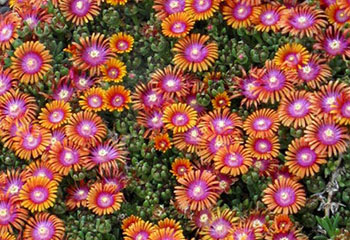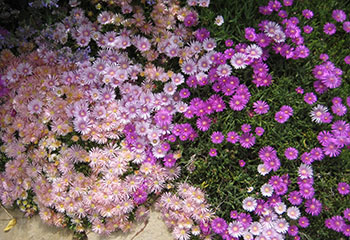Out of Africa, at Home in Colorado
- 2020-04-27
- By mkirk
- Posted in Colorado Master Gardener, The Garden Buzz
By Paula Szilard, Colorado Master Gardener
Delospermas in all colors have become the jewels that adorn our gardens. Who could have imagined this variety of iridescent colors when we only had purple and yellow ones? The blossoms of these plants, commonly known as ice plants, open up to the sun and sparkle like precious stones. Like so many of the subtropical garden plants we love, they hail from South Africa, from the higher elevations in the Drakensberg Mountains and the cold plateaus of the semidesert area known as the Great Karoo, an area where about 40% of all the succulent species on earth are endemic.

Much to their delight, gardeners in Front Range communities now have a greatly expanded range of colors to choose from. The person most responsible for this variety is Panayoti Kelaidis, Senior Curator and Director of Outreach at Denver Botanic Gardens, to whom we are greatly indebted for introducing about half of these plants. The Delosperma plants listed below are labeled hardy to either Zone 4 or 5:
- D. ‘Alan’s Apricot’ (extra large apricot flowers).
- D. cooperi (purple or hot pink).
- D. nubigenum (brilliant yellow).
- Fire Spinner (first multicolor ice plant, with fuchsia centers and orange edges).
- Lavender Ice (yellow centers with dark and pale lavender petals).
- Mesa Verde (D. ‘Kelaidis’, brilliant soft peach, named in honor of DBG’s Panayoti Kelaidis).
- Red Mountain Flame (white centers surrounded by fuchsia and red petals).
- Red Mountain Ice Plant (red with white centers).
- Starburst Ice Plant (purple with large white centers).
- Table Mountain (D. ‘John Proffitt’, fuchsia with small white centers).

Plant Delospermas in a sunny spot in fast draining soil, ideally a sandy soil or a loam with small gravel added for drainage. David Salman, horticulturist and founder of High Country Gardens, recommends against planting them in clay soils. I have clay soils and still wanted to grow them, so I amended the clay with peat and small gravel. The plants have been doing well for almost 20 years! If you don’t want to use peat, use planter’s mix, or vegetable compost and then add small gravel for adequate drainage. It’s also a good idea to plant them by midsummer so they have time to establish before the cold weather hits.
Generally, one good watering a week is adequate, never in winter, though. Delospermas are from summer rainfall areas, so they are unused to much moisture in the winter months. Salman also recommends fertilizing only once a year in the fall with a natural or organic fertilizer that breaks down slowly. He also advises tapering off your watering in the fall to let them dry out and harden off, otherwise you may lose plants when the first major frost hits. Mulching is always a good idea, but never with organic material, such as bark. Use small gravel instead. It keeps the roots moist and the stems dry.
Here we often have long periods of snow cover throughout our winters. Delospermas really don’t respond well to such conditions. If you can, locate your plantings in sunny spots to the south and west of your house where the snow melts more rapidly. Salman suggests using the heavier row covers sold as frost blankets over your plantings for the winter. These keep the plants dry and snug so they can provide another stellar performance in the season to come.
Horticulture Resources
- Garden Buzz Archives
- CSU Extension Resources
- Colorado Master Gardener Program
- Foothills to Plains Native Plant Master Program
- Native Bee Watch Community Science Program
- The Co-Hort Blog
- PlantTalk Colorado
- Soil Testing
- Plant Select
- Emerald Ash Borer
- Japanese Beetle
- Colorado State Forest Service
- Ask an Expert




